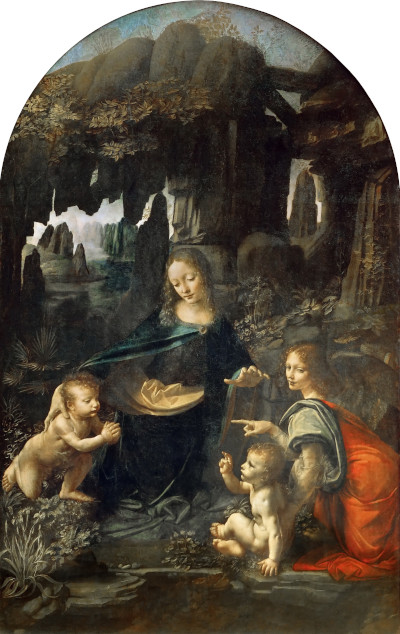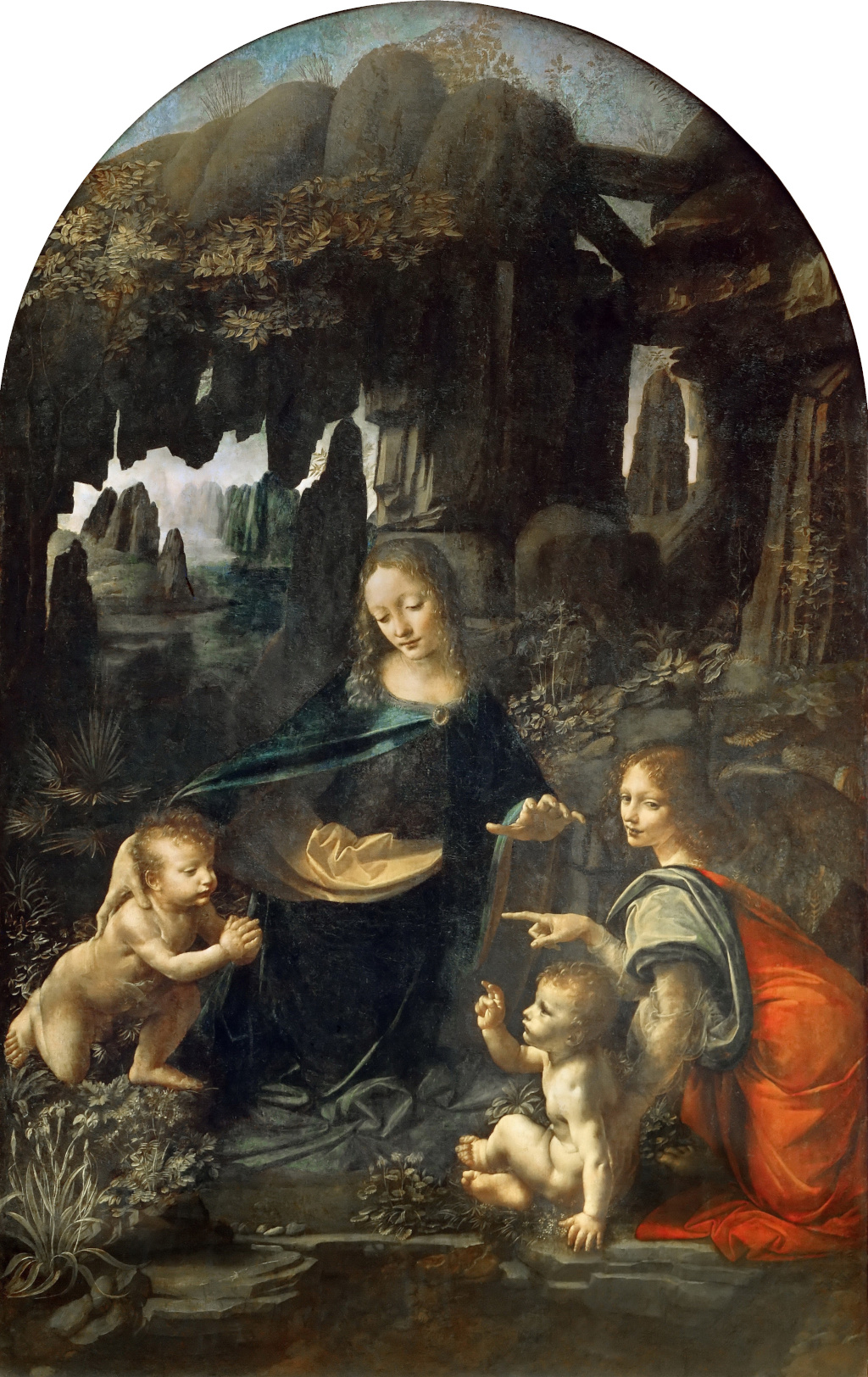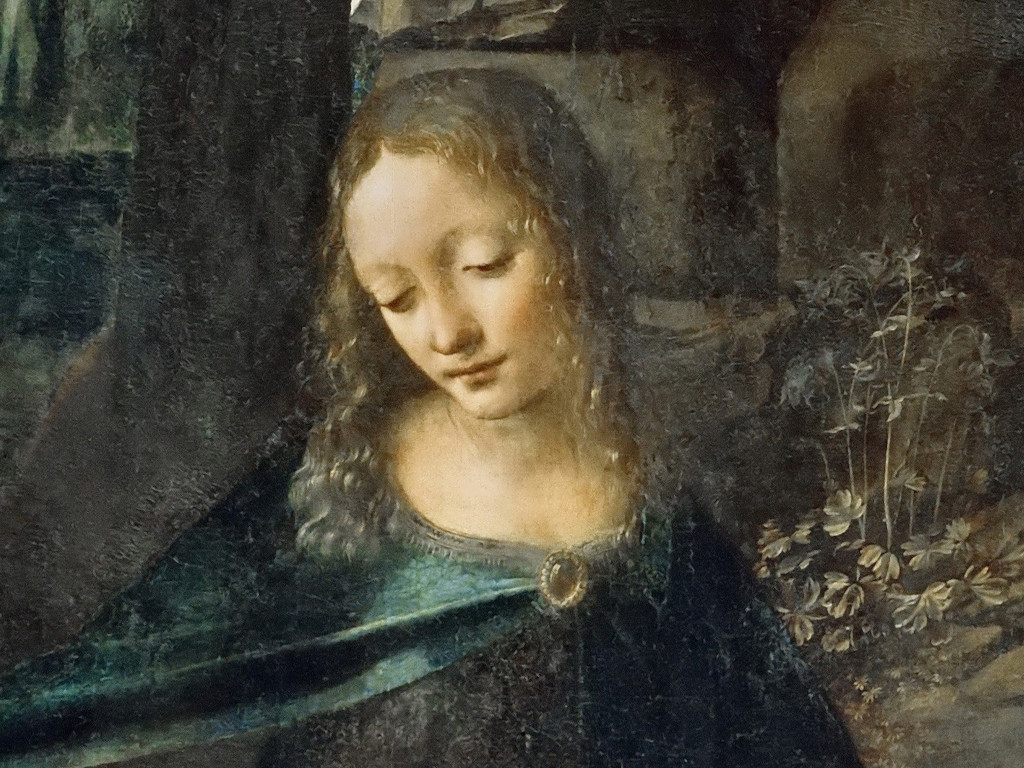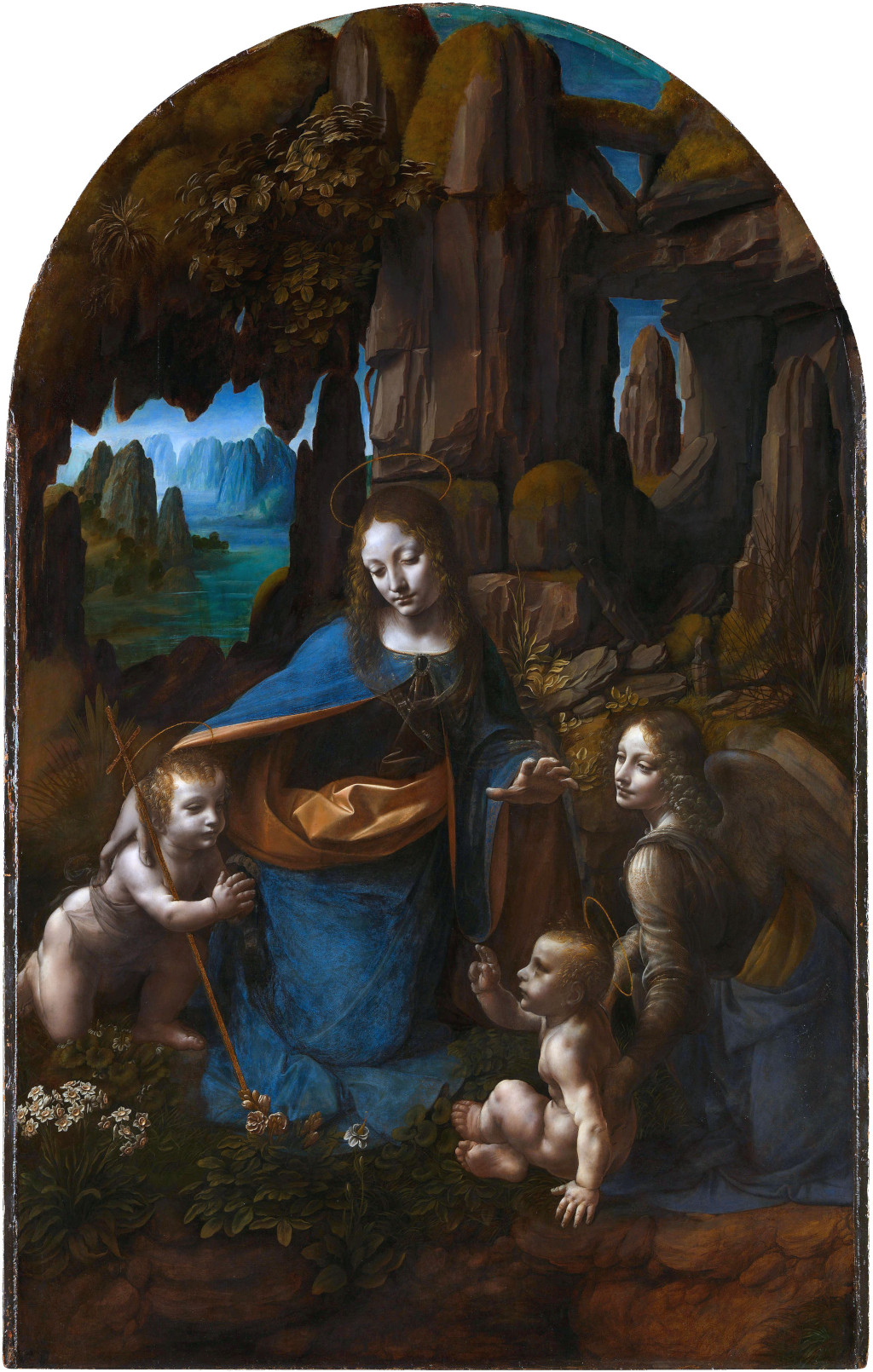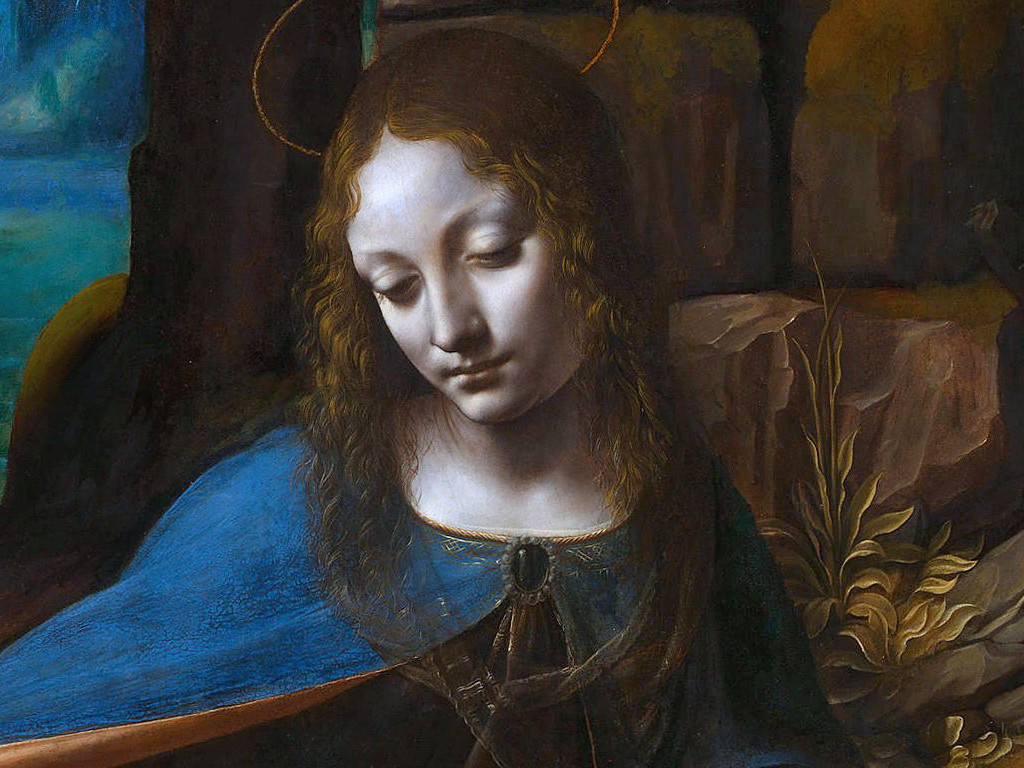The Virgin of the Rocks was the title of two near-identical paintings by Leonardo da Vinci that were completed in around the late 15th century. They reside today in the Louvre in Paris, and the National Gallery in London and were completed in that order.
The mystery still exists today as to why the artist produced two versions of this composition, and which one it was that fulfulled the original commission. It was rare for Da Vinci to create near-identical versions of his paintings, though the most likely scenario is that the original version was sold privately, forcing the artist to create a second one in order to honour the original request. The artist is likely to have been in his early thirties by the time of this painting and had concentrated on mainly religious themes up to that point.
Leonardo da Vinci had set up his own studio around a decade earlier, with the help of his father, and so had now broken away entirely from the influence of his master, Andrea del Verrocchio. Da Vinci still worked collaboratively on some projects, though, and would make use of assistants for the less significant parts of his compositions. Many debates still rage about which elements in his two versions of The Virgin of the Rocks came from his own hand, but most agree that he would certainly have produced the majority of both artworks.
The renewed popularity held for artists such as Leonardo da Vinci is in part due to the exposure of their work within some of the finest art galleries and musuems in the world. To find the two versions of The Virgin of the Rocks in such prestigious locations as the Louvre, Paris and The National Gallery, London, underlines how his career continues to amaze and excite all these centuries later. An increased awareness of his talents as a draughtsman in recent times has also helped the public to better understand his abilities as an all-round artist and innovator.
A fairly recent exhibition in London brought the two artworks together in a landmark display, allowing the general public to compare and contrast the two items in person. Such loans of Da Vinci paintings are fairly rare today, due to the extraordinary value that they possess but also the relatively fragile nature of many artworks from the Renaissance. There are only a few institutions in the world that could organise and finance an exhibition such as this, and the two art museums that host these paintings permanently also have a history of temporary exchanges such as this.
Within this article we examine the original commission and contract as signed by the artist. We track the progress of both paintings and compare the two compositions, which feature some slight differences. There is also discussion about the research that has been carried out in the works in the centuries that have passed since, as well as where the items fit into Da Vinci's oeuvre. Virgin of the Rocks remain amongst his most famous contributions within the painting genre, and marked his continued development as an artist which would last several more decades yet.
Table of Contents
- What is the Meaning of Virgin of the Rocks?
- Background
- Commission, Contract and Payment
- Description
- Differences between the Paris and London versions
- Analysis of the National Gallery, London version
- Analysis of the Louvre, Paris version
- Size and Medium
- Timeline
- Value
- Large Images of the Paris Version
- Large Images of the London Version
- References
What is the Meaning of Virgin of the Rocks?
Virgin of the Rocks is a scene that relates to the holy family’s journey into Egypt, although it was never a biblical event, as such. There are different accounts of the events leading up to the moment captured within these paintings, such as the identity of the angel as well as how they were to eventually come together in this way. The family was heading to Egypt for their own safety, and this passage from the Gospel of Matthew lays at the foundation of what would come later. As with many elements of Christian teaching, narratives have evolved over time, with artists then studying the work of previous generations, leading to certain styles continuing through the centuries, even though they may not have been mentioned in the Bible in the first instance.
Background
Leonardo da Vinci chose to relocate to the city of Milan in around late 1482 and this marked a new stage in his career. Despite Florence's rich cultural scene at that time, the artist must have believed that the much larger city of Milan could provide his career with greater opportunities. The artist offered his services around the region immediately upon arrival, and was particularly keen to join the court of Ludovico Sforza. As their friendship progressed, Sforza recommended Da Vinci alongside a number of assistants to a local church for a commission that would become known as Virgin of the Rocks. Later on, Sforza would commission the artist directly and he would build a huge respect for the Florentine artist over time.
Commission, Contract and Payment
In April 1483, Leonardo da Vinci was commissioned to work alongside brothers Ambrogio and Evangelista de Predis for decorative panels that would adorn an altarpiece in the Chapel of the Immaculate Conception, which was attached to the church of S. Francesco Grande in Milan. The chapel had only recently completed the initial altarpiece, with space deliberately left for this next phase of the project. The contract agreed many elements of the composition and the artists were allowed only seven months to complete the work, a timescale that they were unable to meet for a variety of reasons.
Leonardo da Vinci was tasked with completing the central panel, which became known as Virgin of the Rocks, whilst two side panels were passed over to the two brothers. Ultimately, it would be Ambrogio de Predis who completed the side panels and these reside today in the National Gallery in London, alongside the second version of the main panel. The contract laid out fairly precisely the detail of this middle panel, including the composition, colouring and gilding. It was expected that it would feature the Virgin Mary alongside the Christ child, plus prophets David and Isaiah and some accompanying angels
Description
The four figures placed in the lower half of both versions of Virgin of the Rocks feature Mary with Jesus as a child, as well as infant John the Baptist and an angel named Uriel. They are set within a rocky landscape and it is from this that the common title for these paintings was derived. Leonardo da Vinci continues this use of a rocky environment both below and above the figures, leaving only small areas through which the natural light could show through. This heavy shading allows the painter to carefully control how light comes across the four figures in the foreground, and there is a slight variation between the Paris and London versions in that regard.
Whilst studying as an apprentice within the studio of Andrea del Verrocchio for a number of years, Leonardo was able to master many different genres within the discipline of painting. He would incorporate a number of these within Virgin of the Rocks, giving it a dynamic finish. We find the lifelike portraits along with rolled drapery, plus features of a religious nature and also elements of landscape painting to set the scene. There are even small plants and flowers, the type of flourishes that will remind some of the work of Durer and Botticelli.The similarity between the two suggests that the artist was generally happy with the outcome of the first version, changing little in the follow-up piece.
Differences between the Paris and London versions
The clearest differences between the two versions of Virgin of the Rocks is in the composition of angel Uriel. We see in the earlier version that her right hand is pointing directly across the canvas towards St John the Baptist, whilst her gaze is set upon the Christ child. In the later version she does not point out her hand, and also gazes instead across at St John the Baptist. If we look closer, we can also see that the heads of both the Christ child and the Saint are also slightly different in size between the two paintings, and additionally, St John the Baptist's angle changes too.
The Paris and London versions have varied in condition over the years, and as such their appearances have changed slightly. Some variations that we can spot today may be less about the artist's work, therefore, and more about where the two paintings have been stored and displayed in the centuries that have passed since. There can be no doubt, for example, that their respective brightness and contrast is not consistent from one to the other. A recent exhibition in London in which the two were displayed side by side allowed visitors to understand this very clearly, whilst reproduced images always bring the possibility that we are not comparing like with like.
Analysis of the National Gallery, London version
The version found today in the National Gallery, London was completed during two clear phases of work. The initial work was done between 1495-1499, with further work being carried out between 1506-1508, though all of these dates are only approximate. There are still some section to this painting which have not been entirely finished, though most would not notice this, even in person. Experts have also uncovered many areas of the composition that have been amended over time, including around the facial work and postures of the main figures. Some have suggested that the London version may have been completed collaboratively, with Da Vinci working alongside his asssitants or colleagues (Ambrogio de Predis and Marco d'Oggiono have been mentioned), though others have suggested that both versions were entirely from his hand alone.
Ownership
This painting remained at the Confraternity's chapel in San Francesco Grande for several centuries until passing in 1781 to the Ospedale di Santa Caterina della Ruota. Shortly after that point it was purchased privately by an English painter and collector known as Gavin Hamilton, who immediately brought it across to his native UK. After around a century, and several further sales, it was acquired in 1880 by the National Gallery in London and has remained there ever since. This important institution was able to loan the French version fairly recently for a rare exhibition in which the two paintings were displayed alongside each other.
Analysis of the Louvre, Paris version
The Louvre version of The Virgin of the Rocks, sometimes known as The Virgin and Child with the Infant St John and an Angel or even Nostra Donna, was completed between the years of 1483-1484/85 and was the earlier version of the two by at least a decade. This artwork was commissioned alongside a number of other projects that would together decorate the chapel in the church of San Francesco Grande in Milan, with sculptors and wood carvers also being hired. The overall altarpiece was given a short deadline which, ultimately, Leonardo and his colleagues were able to complete on time, but issues soon arose afterwards that resulted in litigation. Ultimately, it was agreed that a second version was to be created, with that version now found in London.
Size and Medium
The Louvre, Paris version of Virgin of the Rocks is 199 cm × 122 cm (78.3 in × 48.0 in), whilst the National Gallery, London version is 189.5 cm × 120 cm (74.6 in × 47.25 in). They were both completed using oils on wooden panel. In order to deliver two very similar compositions it would have been entirely necessary to choose panels that were of near-identical size, and the intended location of the commissioned piece already had been prepared and so the accepted item would have to match that. All of this would have been stipulated within the original contract as signed by Leonardo da Vinci himself, well before work had even begun.
Timeline
The wide timespans given to both versions of Virgin of the Rocks makes it hard to precisely place them within his oeuvre. Experts have given these artworks a period of at least a decade each in which they were completed, and this typically means that elements were completed in clear stages, with potentially a number of years passing between each stage in which the artist would have concentrated on other projects. The initial Paris version was commenced soon after the artist had arrived in Milan and up to that point he only mainly focused on religious topics, giving us the likes of The Annunciation, Benois Madonna and The Baptism of Christ.
Between the two versions he would complete several portraits, which perhaps were easy to fit in around his other work, as they were single figure depictions, such as Portrait of a Musician, Lady with an Ermine and La Belle Ferronnière. This marked a change in his approach, with only one secular portrait previously existing (Ginevra de' Benci). After the second (London) version was partially completed Da Vinci would then construct perhaps one of his two most famous paintings of all, The Last Supper.
Value
Both the London and Paris versions of Virgin of the Rocks would surely achieve valuations in the hundreds of millions of dollars, were they to be evaluated for the purposes of a sale or insurance. When considering some recent auctions of other Da Vinci paintings, and the global interest today in Renaissance art, one can estimate reasonably accurately as to their respective values. In recent years there has been a growing interest from Asian and Middle Eastern collectors, looking to offer an international display within their galleries. This would bring additional tourism as well as being something of a solid, long-term investment.
Large Images of the Paris Version
Starting with the version that resides within the Louvre in Paris, France, there are larger images of both artworks below. These are imposing canvases that feature precise detail added by Da Vinci and potentially a number of artists, and this work cannot really be appreciated from small images. For those unable to view either painting in person, you might look at the items listed in our references section which feature even larger reproductions of the original works. As you will see below, the London version remains somewhat darkened, whilst the French version, despite receiving less restoration work, is actually a little brighter today, and therefore easier to see the individual elements.
Large Images of the London Version
The second version produced by Leonardo da Vinci now resides within London and came around two decades after the original piece had been completed. The artist chose not to change too much between the two paintings, though this would have been influenced by the original agreement which stipulated how the piece should look and be styled in order to receive payment. The condition of the two paintings is quite different today, though, and you will notice that the London version, below, remains very darker in tone across the majority of the painting when compared to the French version. The similarities between the two, though, ensure that we can understand each one better by studying the two together.
References
- Leonardo. The Complete Paintings and Drawings, Frank Zöllner & Johannes Nathan, Taschen
- Leonardo da Vinci, Walter Isaacson



